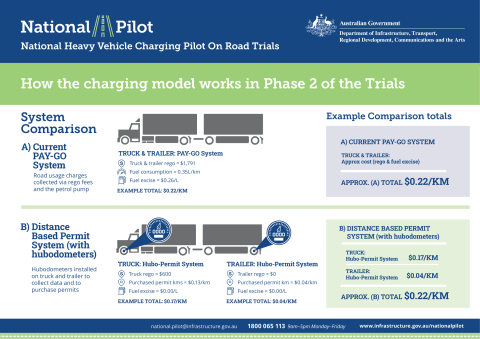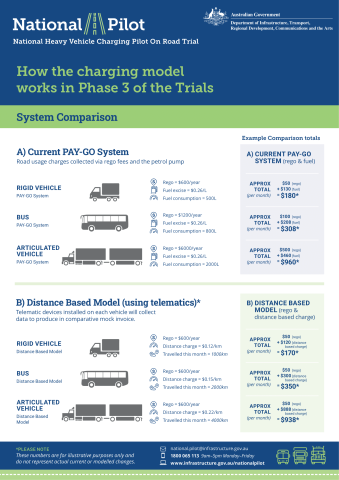The small scale trial
A small-scale 'proof of concept' trial was run over 6 months in 2019–20. The small-scale trial demonstrated that a more direct road user charging model could be trialled more broadly, with participants supporting testing of alternative charging models and data collection technology.
After consultation with industry and an evaluation of this small-scale trial, larger scale trials with up to 100 businesses and over 1000 vehicles were planned.
-
DocumentSmall scale on road trial evaluation report—PDF (823.21 KB)
Large scale trials
Through the National Heavy Vehicle Charging Pilot, the department is testing different ways of charging heavy vehicles for road use than the current system which is based on fuel consumption and registration fees. The Pilot includes larger scale trials run over three phases, with phases 1, 2 and 3 now complete. Additional details and departmental contacts are provided below.
Phase 1
Phase 1 ran over three months and was completed in February 2021. Phase 1 tested a distance-based road user charge, and in response to industry feedback, a co-designed 'mock' invoice. The purpose of the mock invoice was to demonstrate to participants the charges they would pay under a possible new model compared to the current model.
An example of the mock invoice used in Phase 1 is below.
Phase 2
Phase 2 started in July 2022 and concluded in June 2023. During this phase participants tested a direct road user charging model based on distance recorded using hubodometers* (See footnote) and a digital 'mock' permit system.
Participants were provided with hubodometer devices at no cost, with participants recharging their mock permits and recording cumulative distance and associated charges during the trial. Phase 2 data is currently being evaluated.
The diagram below outlines how the charging model worked during Phase 2.
Phase 3
Phase 3 commenced in March 2023 and concluded in late 2024. During Phase 3 participants tested a direct road user charge model based on mass, distance and location, with data collected via telematics** (See footnote) devices.
A key objective of Phase 3 was to test the use of existing commercially available telematics devices. 'Mock' invoices were developed which compared current pay-as you-go (PAYGO) charges, including fuel excise and state/territory vehicle registration, with the alternative charging model. Participants were provided with monthly 'mock' invoices to compare the alternative model charges with current charges during the trial.
The diagram below outlines how the charging model worked during Phase 3.
Note: Phases 2 and 3 are being independently evaluated by Deloitte.
Footnotes
*(A hubodometer is a device mounted on the axle of an automobile or other land vehicle that measures distance traveled)
** (Telematics is a method of monitoring cars, trucks, equipment and other assets by using GPS technology and on-board diagnostics to plot the asset's movements on a computerized map.)



